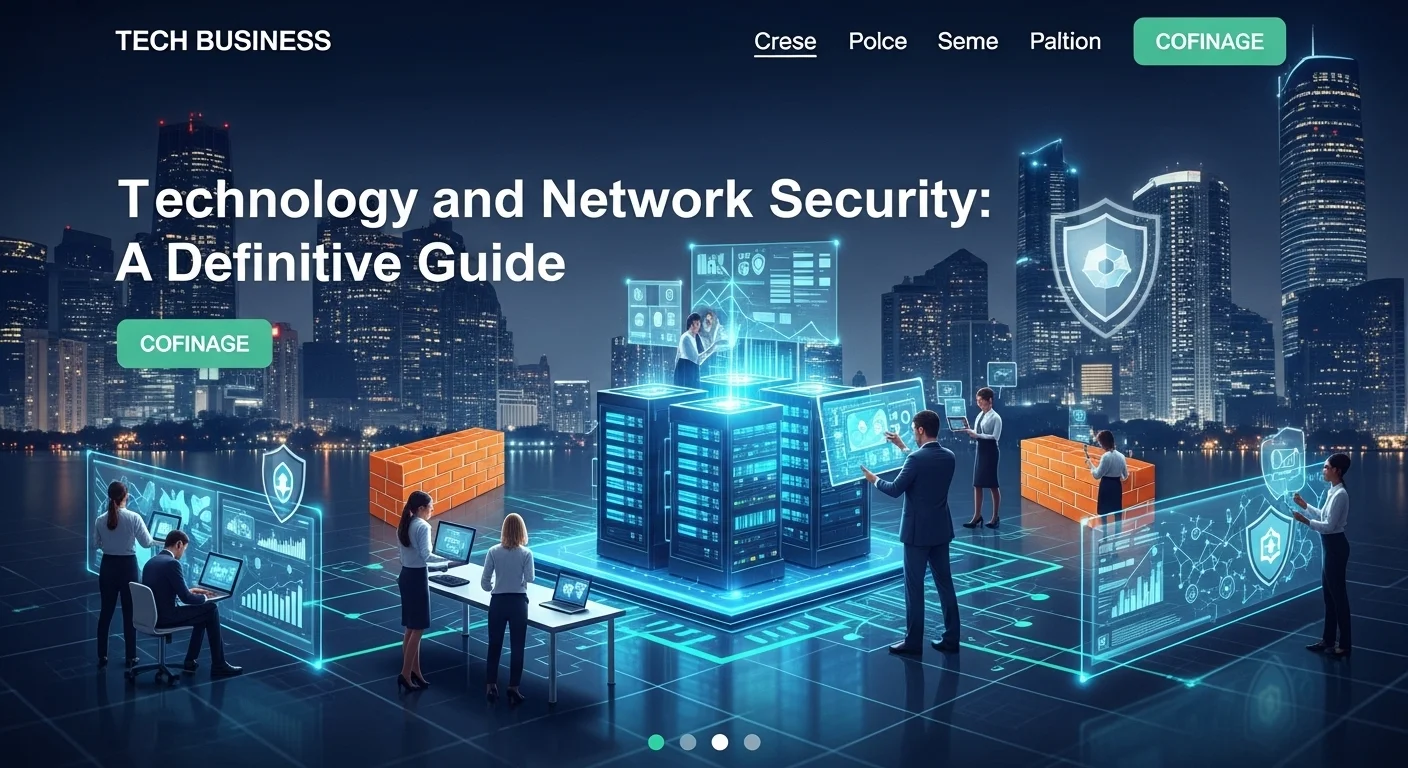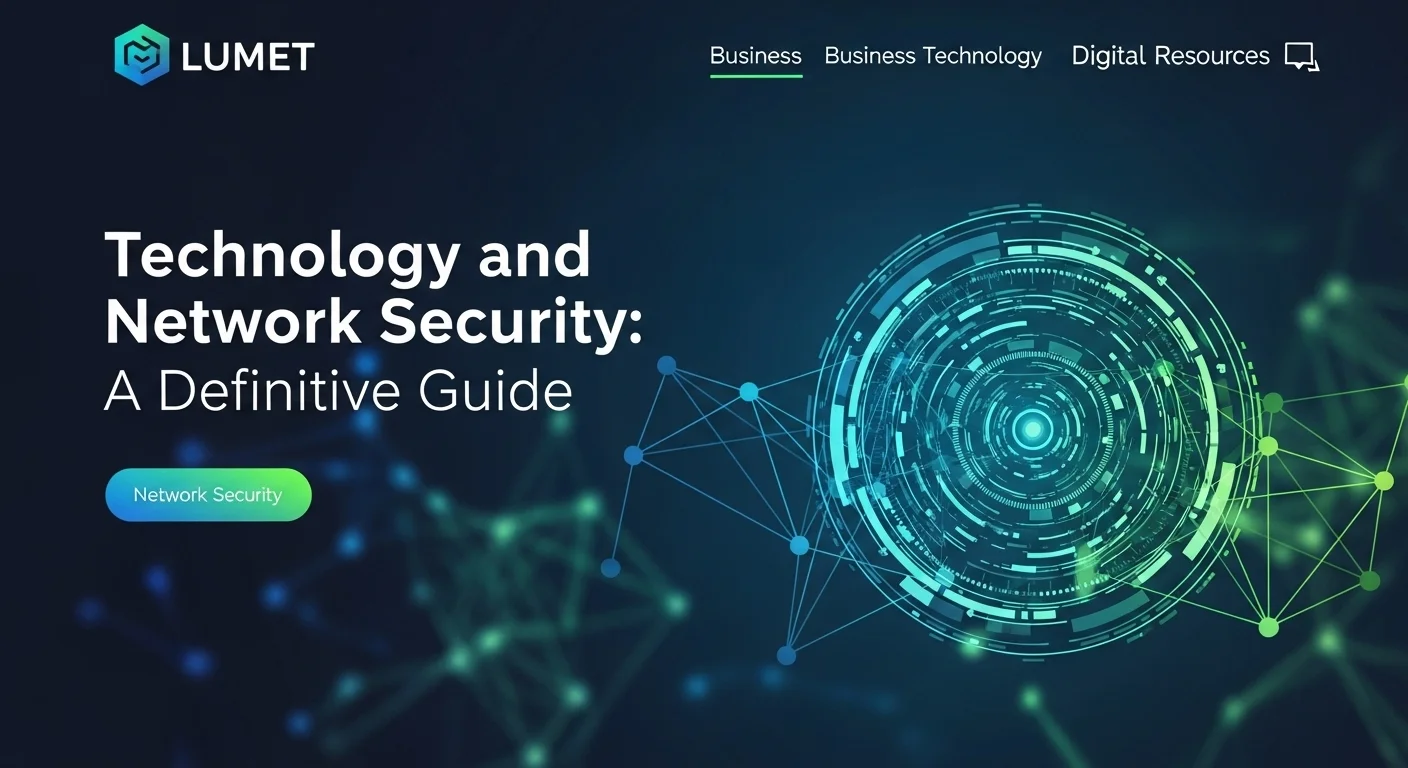Technology and Network Security: A Definitive Guide

Executive Summary
In an era dominated by digital transformation, the importance of a robust network security posture cannot be overstated. This article provides a comprehensive exploration of network security within the broader context of technology, tailored for business leaders, IT professionals, and technology enthusiasts. We delve into the fundamental concepts of what constitutes a secure network, its critical importance for protecting sensitive data, and ensuring business continuity. From understanding the core components of a network security system to implementing advanced strategies involving AI and cloud computing, this guide serves as a vital resource. We will examine the roles of firewalls and other security tools, discuss best practices for data and network security, and offer actionable insights to help organizations fortify their digital defenses against an ever-evolving landscape of cyber threats. This is an essential read for anyone looking to navigate the complexities of network security in today's interconnected world.
Table of Contents
What is Network Security and why is it important in Technology?
In the digital age, where data is often hailed as the new oil, the infrastructure that carries this valuable commodity is under constant threat. This infrastructure, the network, is the backbone of modern technology, connecting everything from corporate servers to personal smart devices. Consequently, network security has emerged from a niche IT concern to a fundamental pillar of business strategy and personal data protection. But what exactly is network security? At its core, network security consists of the policies, practices, and technologies adopted to prevent and monitor unauthorized access, misuse, modification, or denial of a computer network and network-accessible resources. It is a broad term that encompasses a multitude of technologies, devices, and processes. It’s a multi-layered system designed to protect the integrity, confidentiality, and accessibility of computer networks and data using both software and hardware solutions.
The importance of network security in technology is paramount and multifaceted. Every organization, regardless of size or industry, relies on its network to conduct business. This reliance creates vulnerabilities. A breach in network security can lead to devastating consequences, including financial loss, theft of sensitive data and intellectual property, reputational damage, and legal and regulatory penalties. For instance, a compromised network can bring a company’s operations to a standstill, affecting its ability to serve customers and generate revenue. In the healthcare sector, a breach could expose sensitive patient data, while in finance, it could lead to the theft of financial assets. The technological landscape is continuously evolving, with the rise of the Internet of Things (IoT), cloud computing, and remote workforces. This evolution expands the network perimeter, creating new entry points for attackers and making a comprehensive network security system more critical than ever.
The Core Principles of Network Security
To fully grasp its importance, one must understand the foundational principles of network security, often referred to as the CIA triad: Confidentiality, Integrity, and Availability.
- Confidentiality: This principle ensures that information is not disclosed to unauthorized individuals, entities, or processes. It involves measures like encryption, which scrambles data to make it unreadable without the proper key, and access control lists (ACLs), which define who can access specific resources. Protecting confidentiality is crucial for maintaining privacy and complying with regulations like GDPR and HIPAA.
- Integrity: This principle maintains the consistency, accuracy, and trustworthiness of data over its entire lifecycle. Data must not be changed in transit, and steps must be taken to ensure that it cannot be altered by unauthorized people. Technologies like hashing algorithms and digital signatures are used to verify data integrity.
- Availability: This principle ensures that network services and data are available to authorized users whenever they need them. This involves protecting against threats that could disrupt network access, such as Denial-of-Service (DoS) attacks, which flood a network with traffic to overwhelm it. Redundancy, failover systems, and disaster recovery plans are key components of ensuring availability.
A successful data network security strategy effectively balances these three principles. For example, overly restrictive confidentiality controls could hinder the availability of data for legitimate users, so a practical approach is essential.
The Evolving Threat Landscape
The urgency for robust data and network security is driven by a threat landscape that is not only persistent but also constantly evolving. Cybercriminals are becoming more sophisticated, using advanced techniques and tools to exploit vulnerabilities. Some of the most common threats include:
- Malware: This includes viruses, worms, trojans, ransomware, and spyware. Ransomware, in particular, has become a significant threat, where attackers encrypt an organization's data and demand a ransom for its release.
- Phishing: These are fraudulent attempts, usually made through email, to steal sensitive information like usernames, passwords, and credit card details by disguising as a trustworthy entity.
- Denial-of-Service (DoS) and Distributed Denial-of-Service (DDoS) Attacks: These attacks aim to make a machine or network resource unavailable to its intended users by disrupting services.
- Man-in-the-Middle (MitM) Attacks: In a MitM attack, an attacker secretly relays and possibly alters the communication between two parties who believe they are directly communicating with each other.
- Insider Threats: Not all threats are external. A malicious or negligent insider—an employee, former employee, or contractor—with legitimate access can cause significant damage.
This evolving landscape necessitates a proactive and adaptive approach to security. It's no longer sufficient to build a static defense; organizations need a dynamic network security system that can detect and respond to threats in real time.
The Role of Firewalls and Network Security
When discussing foundational security technologies, it's impossible to overlook the role of firewalls. For decades, firewalls and network security have been inextricably linked. A firewall is a network security device that monitors incoming and outgoing network traffic and decides whether to allow or block specific traffic based on a defined set of security rules. Firewalls establish a barrier between a trusted internal network and an untrusted external network, such as the Internet.
There are several types of firewalls, each offering different levels of protection:
- Packet-Filtering Firewalls: The most basic type, they inspect packets and pass or block them based on IP addresses, packet type, port numbers, and other surface-level information. They are fast but offer limited security.
- Stateful Inspection Firewalls: These track the state of active connections and make decisions based on the context of the traffic, offering better security than packet-filtering firewalls.
- Proxy Firewalls (Application-Level Gateways): These operate at the application layer to filter incoming traffic between two networks. They provide granular security but can impact performance.
- Next-Generation Firewalls (NGFWs): These are advanced firewalls that combine traditional firewall capabilities with additional functionalities like encrypted traffic inspection, intrusion prevention systems (IPS), and application-level inspection. NGFWs provide a more holistic approach to firewalls and network security.
While firewalls are a critical component, they are just one piece of the puzzle. A comprehensive network security system integrates firewalls with other technologies like antivirus software, intrusion detection and prevention systems (IDS/IPS), and virtual private networks (VPNs) to create a defense-in-depth strategy. This layered approach ensures that if one security control fails, others are in place to thwart an attack.
Business Applications and Benefits
Implementing a robust network security framework offers numerous benefits to a business. The most obvious is the protection of assets. By securing the network, a company protects its sensitive data, which is often its most valuable asset. This includes customer information, financial records, and intellectual property. Protecting this data is not just about preventing theft; it's also about maintaining customer trust and brand reputation. A single, well-publicized data breach can erode years of customer loyalty and cause irreparable damage to a brand's image.
Furthermore, strong data network security is essential for regulatory compliance. Many industries are subject to strict regulations regarding data privacy and security, such as the Health Insurance Portability and Accountability Act (HIPAA) for healthcare, the Payment Card Industry Data Security Standard (PCI DSS) for retail, and the General Data Protection Regulation (GDPR) in Europe. Non-compliance can result in hefty fines, legal action, and loss of the license to operate. A well-designed network security system helps organizations meet these requirements and demonstrate due diligence in protecting sensitive information.
Another significant benefit is improved business continuity. Cyberattacks can disrupt operations, leading to downtime that costs money and productivity. By preventing these attacks, network security ensures that employees can access the tools and data they need to do their jobs without interruption. This is particularly important in today's 24/7 business environment, where any amount of downtime can have a significant financial impact.
In conclusion, the integration of technology into every facet of business has made network security an indispensable function. It is not merely a technical issue but a critical business enabler. By understanding the core principles, recognizing the evolving threats, and implementing a layered defense strategy that includes robust firewalls and network security policies, organizations can protect their assets, comply with regulations, and ensure the continuity of their operations. The investment in a comprehensive data and network security plan is an investment in the long-term success and resilience of the enterprise in an increasingly digital and dangerous world. The conversation is no longer about *if* an organization will be targeted, but *when*, making preparedness the ultimate competitive advantage.

Complete guide to Network Security in Technology and Business Solutions
Navigating the complex world of network security requires a deep understanding of its technical methods, business techniques, and the vast array of available resources. For any modern enterprise, establishing a resilient defense against cyber threats is not a one-time project but an ongoing, strategic endeavor. This guide provides a comprehensive overview of the components that constitute a robust network security system, explores various business solutions, and compares different approaches to help organizations make informed decisions.
Technical Methods: The Building Blocks of a Secure Network
A secure network is built upon a foundation of technical controls designed to protect the CIA triad—Confidentiality, Integrity, and Availability. These controls can be categorized into several key areas, each addressing a specific aspect of data network security.
1. Access Control
Access control is the selective restriction of access to a resource. The goal is to ensure that only authorized users can access network resources. This is typically achieved through:
- Authentication: Verifying the identity of a user. This can be something the user knows (password), something the user has (security token), or something the user is (biometrics). Multi-Factor Authentication (MFA) is now a standard, requiring two or more verification methods.
- Authorization: Granting or denying specific permissions to an authenticated user. This is often managed through Role-Based Access Control (RBAC), where permissions are assigned to roles rather than individual users.
- Network Access Control (NAC): NAC solutions provide visibility into the devices connecting to the network and enforce security policies. They can deny access to non-compliant devices or place them in a quarantined area, thus preventing potentially infected devices from compromising the network.
2. Threat Prevention and Detection
Preventing threats from entering the network and detecting those that do are critical functions of any network security system. Key technologies include:
- Firewalls: As discussed previously, firewalls and network security are foundational. Next-Generation Firewalls (NGFWs) are essential for modern threat defense, offering integrated intrusion prevention, application control, and advanced malware protection.
- Intrusion Detection and Prevention Systems (IDS/IPS): An IDS monitors network traffic for suspicious activity and issues alerts, while an IPS can actively block or prevent detected intrusions. They are crucial for identifying and stopping attacks in real-time.
- Antivirus and Anti-Malware Software: This software is designed to detect, prevent, and remove malicious software. It should be installed on all endpoints and servers connected to the network.
- Sandboxing: This is a security mechanism for separating running programs, usually in an effort to mitigate system failures or software vulnerabilities from spreading. It allows for the safe execution of suspicious code without affecting the host device or network.
3. Data Protection and Encryption
Protecting data, both in transit and at rest, is a core objective of data and network security. Encryption is the primary tool for this.
- Virtual Private Networks (VPNs): VPNs create a secure, encrypted tunnel over a public network like the Internet. They are essential for protecting data transmitted by remote workers and between different office locations.
- Data Loss Prevention (DLP): DLP solutions are a set of tools and processes used to ensure that sensitive data is not lost, misused, or accessed by unauthorized users. They can classify and monitor sensitive data to prevent it from being exfiltrated from the network.
- Encryption Protocols: Protocols like Transport Layer Security (TLS) and Secure Sockets Layer (SSL) are used to encrypt data in transit over the web. At-rest data on servers and databases should also be encrypted to protect it in case of physical theft or unauthorized access.
4. Network Segmentation
Network segmentation involves dividing a computer network into smaller, isolated subnetworks or segments. This practice contains threats within a smaller area of the network, preventing them from spreading. For example, a guest Wi-Fi network should be completely isolated from the internal corporate network. Similarly, sensitive data, like financial records, can be stored on a separate network segment with stricter access controls. This micro-segmentation approach is a cornerstone of a Zero Trust security model, which assumes no user or device is trustworthy by default.
Business Techniques and Strategies
Technology alone is not enough. A successful network security strategy must be supported by sound business techniques and a strong security culture.
1. Security Policy Development
A comprehensive set of security policies forms the backbone of an organization's security posture. These policies should clearly define the rules and procedures for all individuals accessing and using the organization's IT assets. Key policies include an Acceptable Use Policy (AUP), an Incident Response Plan, a Disaster Recovery Plan, and a Data Classification Policy.
2. Employee Training and Awareness
Humans are often the weakest link in the security chain. Phishing attacks, for example, rely on tricking employees into revealing sensitive information or downloading malware. Regular security awareness training is crucial to educate employees about common threats and the security policies of the organization. This training should be ongoing and include simulated phishing exercises to test employee vigilance.
3. Risk Assessment and Management
Organizations must regularly conduct risk assessments to identify, analyze, and evaluate security risks. This involves identifying valuable assets, potential threats, and existing vulnerabilities. Once risks are identified, they can be managed by either mitigating the risk (implementing security controls), transferring the risk (e.g., through cybersecurity insurance), accepting the risk, or avoiding the risk altogether. This process helps in prioritizing security investments and focusing resources on the most significant threats.
4. Incident Response and Recovery
No network security system is foolproof. Therefore, having a well-defined Incident Response Plan (IRP) is critical. An IRP outlines the steps to be taken in the event of a security breach. It should include procedures for detecting, containing, eradicating, and recovering from an incident. Regular drills and simulations can help ensure that the response team is prepared to act quickly and effectively, minimizing the damage from an attack.
Available Resources and Comparisons
The market for network security solutions is vast and can be overwhelming. Solutions range from all-in-one platforms to specialized point products. Here’s a comparison of some common approaches and resources.
1. In-House vs. Managed Security Services (MSSP)
- In-House Security: Larger organizations with sufficient resources may choose to build and manage their own Security Operations Center (SOC). This provides maximum control and customization but requires significant investment in technology and skilled personnel. Maintaining a 24/7 SOC is a major challenge.
- Managed Security Service Providers (MSSPs): For many small and medium-sized businesses (SMBs), outsourcing security to an MSSP is a more viable option. MSSPs offer services like 24/7 monitoring, threat intelligence, and incident response at a fraction of the cost of an in-house SOC. When choosing an MSSP, it's important to evaluate their expertise, service level agreements (SLAs), and the technologies they use.
2. All-in-One vs. Best-of-Breed Solutions
- All-in-One (Unified Threat Management - UTM): UTM appliances combine multiple security features—such as firewalls and network security functions, IDS/IPS, and VPN—into a single device. They are often simpler to manage and more cost-effective, making them a good choice for SMBs. However, they may not offer the same level of performance or advanced features as specialized solutions.
- Best-of-Breed: This approach involves selecting the best available product for each specific security function from different vendors. This can provide superior protection and flexibility but often leads to a more complex and costly security architecture. Integrating and managing products from multiple vendors can also be a significant challenge.
3. Open Source vs. Commercial Tools
- Open Source Tools: There is a wide range of powerful open-source security tools available, such as Snort (IDS), OpenVAS (vulnerability scanner), and pfSense (firewall). These tools are free and highly customizable, but they require significant technical expertise to deploy and maintain. They also typically lack the dedicated support offered by commercial vendors.
- Commercial Tools: Commercial solutions from vendors like Cisco, Palo Alto Networks, Fortinet, and Check Point offer comprehensive features, user-friendly interfaces, and professional support. While they come with a higher price tag, they are often the preferred choice for organizations that require enterprise-grade reliability and support for their data and network security.
Conclusion: Building a Holistic Defense
Creating a complete and effective network security strategy is a complex but essential task for any business operating in the modern technological landscape. It requires a holistic approach that combines robust technical controls with sound business practices and a vigilant security culture. The foundation of this strategy is a well-architected network security system that incorporates layers of defense, including advanced firewalls and network security measures, intrusion prevention, and comprehensive access controls. The choice between in-house and managed services, or all-in-one versus best-of-breed solutions, will depend on the organization's specific needs, resources, and risk appetite. Ultimately, the goal is to build a resilient and adaptive defense that can protect the organization's critical assets from an ever-changing array of threats, ensuring the integrity and continuity of the business. This continuous cycle of assessment, protection, detection, and response is the hallmark of a mature data and network security program.

Tips and strategies for Network Security to improve your Technology experience
In today's hyper-connected world, a secure technology experience is not a luxury; it is a necessity. For businesses, it underpins operational stability and customer trust. For individuals, it protects personal information and financial assets. Improving your network security posture involves more than just installing software; it requires a strategic approach that combines best practices, the right tools, and a commitment to continuous improvement. This section offers practical tips and advanced strategies to enhance your network security system and overall technology experience.
Best Practices for Foundational Security
Whether you are a small business owner or an IT manager at a large enterprise, certain best practices form the non-negotiable foundation of a secure network.
Implement a Strong Password Policy: This is the first line of defense. Enforce the use of complex passwords (a mix of upper and lower case letters, numbers, and symbols) and a minimum length of 12-14 characters. More importantly, deploy Multi-Factor Authentication (MFA) wherever possible. MFA adds a critical layer of security that can thwart attackers even if they manage to steal a password.
Keep All Software and Systems Updated: Cybercriminals often exploit known vulnerabilities in software to gain access to networks. Regularly update operating systems, applications, and firmware on all devices, including servers, laptops, and network hardware. Automated patch management systems can streamline this process and ensure no critical updates are missed. This is a fundamental aspect of maintaining effective data network security.
Secure Your Wireless Networks: Default router settings are often insecure. Change the default administrator password and SSID (network name). Use WPA3 encryption, the latest and most secure standard for Wi-Fi. Create a separate guest network for visitors to prevent them from accessing your primary internal network.
Practice Network Segmentation: Do not operate a flat network where every device can communicate with every other device. Segment your network to isolate critical systems. For example, point-of-sale systems should be on a different network segment from corporate email. This contains the impact of a breach and makes it harder for attackers to move laterally across your network.
Conduct Regular Backups: In the event of a ransomware attack or system failure, having recent, reliable backups is your ultimate safety net. Follow the 3-2-1 rule: have at least three copies of your data, on two different media types, with one copy stored off-site (or in the cloud). Regularly test your backups to ensure they can be restored successfully.
Leveraging Business Tools for Enhanced Security
A variety of tools can automate and strengthen your security efforts, creating a more robust network security system.
Unified Threat Management (UTM) / Next-Generation Firewalls (NGFW): For a centralized and simplified approach, UTMs and NGFWs are invaluable. These devices consolidate multiple security functions—including advanced firewalls and network security policies, intrusion prevention, content filtering, and VPN capabilities—into a single platform. This simplifies management and ensures consistent policy enforcement across the network.
Endpoint Detection and Response (EDR): Traditional antivirus is no longer sufficient. EDR solutions provide continuous monitoring and response to advanced threats on endpoints (laptops, servers, etc.). They can detect suspicious behavior, isolate infected devices from the network, and provide tools for investigation and remediation. EDR is a critical component of modern data and network security.
Security Information and Event Management (SIEM): A SIEM system aggregates log data from across your network—from firewalls, servers, and applications—into a single centralized platform. It analyzes this data in real-time to identify potential security threats and policy violations. Advanced SIEMs use AI and machine learning to detect anomalies that might indicate a sophisticated attack.
Vulnerability Management Tools: These tools continuously scan your network for vulnerabilities, such as unpatched software or misconfigurations. They provide detailed reports and prioritize vulnerabilities based on severity, allowing IT teams to focus on fixing the most critical issues first. Proactive vulnerability management is key to reducing the attack surface.
Advanced Strategies for a Future-Proof Network
As technology evolves, so must your security strategies. Adopting a forward-looking approach will help you stay ahead of emerging threats.
Adopt a Zero Trust Architecture (ZTA): The traditional model of a trusted internal network and an untrusted external network is obsolete. A Zero Trust model assumes that threats exist both inside and outside the network. It operates on the principle of 'never trust, always verify.' Every access request is authenticated, authorized, and encrypted before being granted. This requires strong identity management, micro-segmentation, and continuous monitoring of all network traffic.
Harness the Power of AI and Machine Learning: Artificial intelligence is revolutionizing network security. AI-powered tools can analyze vast amounts of data to identify subtle patterns of malicious activity that would be impossible for human analysts to detect. They can predict potential attacks, automate threat responses, and adapt security controls in real-time. Integrating AI into your network security system can significantly enhance your detection and response capabilities.
Secure the Cloud: As more businesses move to the cloud, securing cloud environments becomes critical. This is a shared responsibility between the cloud provider and the customer. While the provider secures the underlying infrastructure, the customer is responsible for securing their data and applications in the cloud. This involves properly configuring cloud services, managing access controls, and using cloud-native security tools like Cloud Security Posture Management (CSPM) and Cloud Access Security Brokers (CASB).
Develop a Robust Incident Response Plan: It's not a matter of *if* but *when* a security incident will occur. A well-documented and practiced Incident Response (IR) plan is crucial for minimizing the impact of a breach. The plan should define roles and responsibilities, communication protocols, and the technical steps for containment, eradication, and recovery. Regular tabletop exercises can ensure your team is ready to execute the plan effectively.
Enhancing the Human Element
Technology and strategies are only part of the solution. The people within an organization are a critical component of its defense.
Continuous Security Awareness Training: Go beyond the annual compliance training. Implement a continuous program that includes regular phishing simulations, security newsletters, and brief, engaging training modules. A well-informed workforce is your best defense against social engineering attacks.
Foster a Culture of Security: Security should be everyone's responsibility, from the CEO down. When leadership champions security, it becomes embedded in the company culture. Encourage employees to report suspicious activity without fear of blame. Reward security-conscious behavior.
Quality External Resources
Staying informed is key in the fast-paced world of cybersecurity. Reputable sources can provide valuable insights into new threats and defensive strategies. For in-depth technical guides, best practices, and threat intelligence, a great resource is the SANS Institute, a trusted leader in cybersecurity training and research.
In conclusion, improving your technology experience through better network security is an ongoing journey, not a destination. It requires a multi-layered approach that combines foundational best practices, modern business tools, and advanced, forward-looking strategies. By fortifying your defenses with a robust network security system, including essential elements like firewalls and network security protocols, and by empowering your people with knowledge, you can create a resilient environment. This comprehensive approach to data and network security will not only protect your valuable assets but also enable your organization to innovate and thrive with confidence in an increasingly digital future.
Expert Reviews & Testimonials
Sarah Johnson, Business Owner ⭐⭐⭐
The information about Network Security is correct but I think they could add more practical examples for business owners like us.
Mike Chen, IT Consultant ⭐⭐⭐⭐
Useful article about Network Security. It helped me better understand the topic, although some concepts could be explained more simply.
Emma Davis, Tech Expert ⭐⭐⭐⭐⭐
Excellent article! Very comprehensive on Network Security. It helped me a lot for my specialization and I understood everything perfectly.



